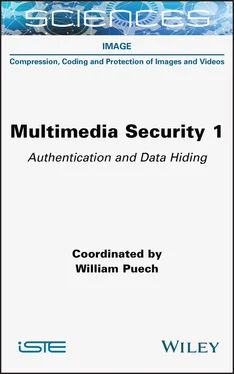Apart from any fair dealing for the purposes of research or private study, or criticism or review, as permitted under the Copyright, Designs and Patents Act 1988, this publication may only be reproduced, stored or transmitted, in any form or by any means, with the prior permission in writing of the publishers, or in the case of reprographic reproduction in accordance with the terms and licenses issued by the CLA. Enquiries concerning reproduction outside these terms should be sent to the publishers at the undermentioned address:
ISTE Ltd
27-37 St George’s Road
London SW19 4EU
UK
www.iste.co.uk
John Wiley & Sons, Inc.
111 River Street
Hoboken, NJ 07030
USA
www.wiley.com
© ISTE Ltd 2022
The rights of William Puech to be identified as the author of this work have been asserted by him in accordance with the Copyright, Designs and Patents Act 1988.
Any opinions, findings, and conclusions or recommendations expressed in this material are those of the author(s), contributor(s) or editor(s) and do not necessarily reflect the views of ISTE Group.
Library of Congress Control Number: 2021948467
British Library Cataloguing-in-Publication Data
A CIP record for this book is available from the British Library
ISBN 978-1-78945-026-2
ERC code:
PE6 Computer Science and Informatics
PE6_5 Cryptology, security, privacy, quantum cryptography
PE6_8 Computer graphics, computer vision, multi media, computer games
Foreword by Gildas Avoine
Gildas AVOINE
Director of the CNRS Computer Security Research Network, INSA Rennes, University of Rennes, IRISA, CNRS, France
French academic and industrial research in cybersecurity is at the forefront of the international scene. While France cannot claim to have sovereignty over cybersecurity technologies, it undeniably possesses a wealth of skills, as French expertise covers all areas of cybersecurity.
Research in cryptography illustrates French excellence, but it should not overshadow other domains where French influence is just as remarkable, including formal methods for security, protection of privacy, security of systems, software and networks, security of hardware systems and multimedia data security, according to the classification proposed by the CNRS Computer Security Research Network (GdR).
The security of multimedia data is covered in this book. The evolution of our society from the written word to sound and image, with the notable arrival of the mobile phone and the democratization of the Internet has brought about new security needs. These are only the beginning of the transformation of our society, and the recent deployment of videoconferencing shows that research into the security of multimedia data is constantly confronted with new scientific challenges.
The complexity of the subject and its multidisciplinary dimension, which primarily combines signal processing and cryptography, are perfectly illustrated by the variety of subjects detailed throughout this book. The chapters thus reveal the scientific obstacles to be dealt with by the community, by anchoring them in real scenarios, such as the fraudulent copying of films, the deception of artificial intelligence or the spreading of doctored images on social media.
This book, made up of two volumes, is thus promised to become a reference in the field of multimedia data security, an introduction that is both exhaustive and in-depth that students, engineers and researchers will be able to appreciate through more than 600 pages enriched with numerous references. Everyone can indulge in their favorite kind of reading, whether linear or random.
Finally, I would like to thank all of the authors for their commitment to supporting the scientific community, and I would particularly like to thank William Puech for editing this edition of the book. William, alongside Patrick Bas and then Caroline Fontaine, is responsible for the theme of multimedia data security within the Computer Security GdR, thus allowing the entire cybersecurity community to better understand this fascinating subject.
Happy reading!
Foreword by Cédric Richard
Cédric RICHARD
Director of the CNRS GdR ISIS, Côte d’Azur Observatory, University of Côte d’Azur, Nice, France
With the relentless increase in bandwidth and storage space, as well as the proliferation of mobile devices and the development of new standards, multimedia data is affecting our societies by changing the way that we access data and information. It is also changing our relationship to culture, by transforming interactions between individuals and their relationships with organizations. Multimedia activities are present in all major sectors of activity (security, health, telecommunications, etc.) and have supported their successive developments because of the common backbone they build, from information support to the application and user.
In this context, by protecting confidentiality and copyright, verifying integrity, analyzing and authenticating content, tracing copies and controlling access, particularly critical questions about multimedia data security are being asked. For example, the protection strategies implemented must take into account the specific needs of multimedia while meeting the requirements of the means of communication, thus establishing a compromise. A wrong approach can indeed lead to excessive coding of the data, or the alteration of their perceptual quality, and thus failure in the targeted security objectives.
As an interface discipline, the art of multimedia security is difficult!
However, with this two-part book, William Puech and his co-authors take up the challenge brilliantly by painting an exhaustive and current panorama of multimedia security. They offer an in-depth analysis of authentication and hidden data embedding methods, biometric technologies and multimedia protection and encryption processes. Without giving in to an outdated formalism that could hinder the fluidity of their presentations, the authors captivate the reader by presenting the state of the art of each subject directly and in an illustrative way.
William Puech and the contributors to this book have provided considerable work to their French-speaking scientific communities of information, signal, image, vision and computer security, represented by the two appropriate French GdR groups of the CNRS. I would like to express all of my gratitude to them.
William PUECH
LIRMM, Université de Montpellier, CNRS, France
Nowadays, more than 80% of transmitted data on social media and archived in our computers, tablets, mobile phones or in the cloud is multimedia data. This multimedia data mainly includes images (photographs, computer-generated images), videos (films, animations) or sound (music, podcasts), but equally more and more three-dimensional (3D) data and scenes, for applications ranging from video games to medical data, passing through computer-aided design, video surveillance and biometrics. It is becoming necessary, urgent, not to say vital, to secure this multimedia data during its transmission or archiving, but also during its visualization. In fact, with everything digital, it is becoming increasingly easy to copy this multimedia data, to view it without rights, to appropriate it, but also to counterfeit it.
Over the last 30 years, we have observed an expansive development around multimedia security, both internationally and in France. In fact, at the French level, there are dozens of research teams in laboratories, but also a large number of industrials, who are focusing their activities on these aspects. This activity can also be found in several GdR (research groups) of the CNRS, but in particular the GdR ISIS (information, signal, image and vision) and the GdR computer security.
Читать дальше












